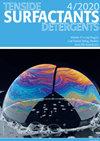豆甾醇对脂质层胃脂肪酶吸附的变化
IF 1.2
4区 工程技术
Q4 CHEMISTRY, APPLIED
引用次数: 0
摘要
摘要利用表面等离子体共振研究了胃脂肪酶(GL)与脂质层结合的阶段,该阶段通过豆甾醇与脂质的比例进行调节。当该层形成在疏水表面上时,更多的豆甾醇仅在二棕榈酰磷脂酰胆碱(DPPC)层中导致较低的表面密度。豆甾醇的加入被认为使DPPC层的相(冷凝液相)转变为更接近二油酰基磷脂酰胆碱(DOPC)层的相和(膨胀液相)。当比例大于15:85时,豆甾醇对DPPC的作用是饱和的。GL的吸附行为表现出与脂质形成相似的趋势。吸附量随着豆甾醇与脂质比例的增加而增加,最高可达15:85。在膨胀液相的DOPC层上,似乎发生了最多的吸附,并且与15:85的DPPC层中的吸附难以区分。吸附GL的表面密度被解释为豆甾醇依赖性DPPC的分数,对于10:90、5:95和0:100的DPPC,分别为0.33、0.67和1.00。此外,平衡常数在1×1013之间 M−1和2×1013 M−1,吸附动力学表明吸附速率常数随着比例的增加而增加,直到15:85。本文章由计算机程序翻译,如有差异,请以英文原文为准。
Change in gastric-lipase adsorption on lipid layer by stigmasterols
Abstract Gastric-lipase (GL) binding to a lipid layer was investigated for the phase of the layer adjusted with the ratio of stigmasterol to the lipid using surface plasmon resonance. While the layer was formed on the hydrophobic surface, more stigmasterol led to lower surface density only in the dipalmitoylphosphatidylcholine (DPPC) layer. The addition of stigmasterol was believed to transform the phase (condensed liquid-phase) of DPPC layer closer to the phase (expanded liquid-phase) of dioleoylphosphatidylcholine (DOPC) layer. At a ratio greater than 15:85, the effect of the stigmasterol on the DPPC was saturated. The adsorption behavior of GL showed the similar trend with the lipid formation. The adsorption increased with the increase in the ratio of stigmasterol to lipid up to 15:85. On the DOPC layer of the expanded liquid-phase, the most adsorption seemed to occur and was indistinguishable from that in the DPPC layer of 15:85. The surface density of the adsorbed GL was interpreted into the fraction of the stigmasterol-dependent DPPC, 0.33, 0.67, and 1.00 for 10:90, 5:95, and 0:100 of DPPC. Furthermore, the equilibrium constant was between 1 × 1013 M−1 and 2 × 1013 M−1 and the kinetics of the adsorption showed an increase in the adsorption rate constant with the increase of the ratio up to 15:85.
求助全文
通过发布文献求助,成功后即可免费获取论文全文。
去求助
来源期刊

Tenside Surfactants Detergents
工程技术-工程:化工
CiteScore
1.90
自引率
10.00%
发文量
57
审稿时长
3.8 months
期刊介绍:
Tenside Surfactants Detergents offers the most recent results of research and development in all fields of surfactant chemistry, such as: synthesis, analysis, physicochemical properties, new types of surfactants, progress in production processes, application-related problems and environmental behavior. Since 1964 Tenside Surfactants Detergents offers strictly peer-reviewed, high-quality articles by renowned specialists around the world.
 求助内容:
求助内容: 应助结果提醒方式:
应助结果提醒方式:


